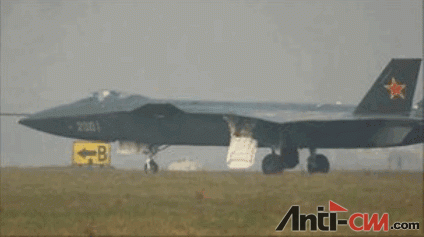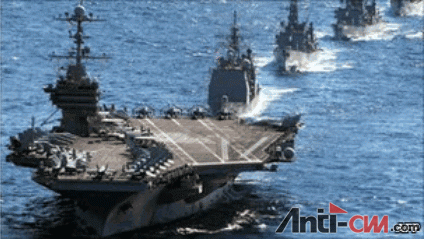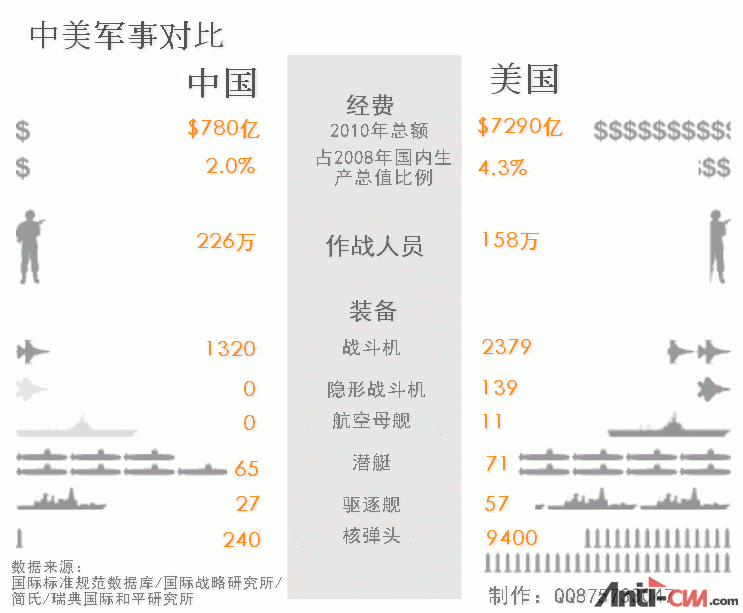本帖最后由 連長 于 2011-1-12 07:02 编辑
【中文标题】看法:新一轮中美高科技军备竞赛?
【原文标题】Viewpoint: A new Sino-US high-tech arms race?
【登载媒体】BBC
【链接地址】http://www.bbc.co.uk/news/world-asia-pacific-12154991
【译者】高贵无比举止得体仪表堂堂的连长同学
英国皇家联合军种研究院亚洲防务署的负责人亚历山大·尼尔(Alexander Neill)认为:新一轮的中美高科技军备竞赛拉开了帷幕。

微笑的背后,双方仍旧担忧着对方的意图。
在北京的防务峰会上,尽管有着官气十足的微笑和简练优雅的握手打掩护,但中美关系依旧充斥着难以预料的不愉快。
去年,因美国重启总价64亿美元的对台军售案,北京冻结了双方军事联系。美国曾借一次重要的战略对话,请求恢复中断的关系,但却得到了一个冷淡的回应。
人民解放军敌视美国态度在过去的一年里已经大大减弱。
美国不断巩固与台湾的防务合作,近几个月里还在中国的后院举行了大规模的海战演习,还加强了与东亚盟国的伙伴关系。
这些刺激行动已经让中国愤怒不已,并对美国的军事包围感到担忧。
美国的刺激是基于近期中国海军和渔船在西太平洋接连骚扰美国海军及其盟友。
中国在国际安全事务的重要战略对话中表现出的不妥协态度也同样令美国头疼不已,尤其是在朝鲜半岛持续高度紧张的局势,并且北韩核扩散问题仍没有受到约束的情况下。
但五角大楼最忧虑的是它没能察觉中国军事科学极快地发展速度,以及它是否还有足够的能力去约束东亚的军备竞赛。
“要害战”

最近曝出的有可能是中国国产的隐形战机的样机照片
尽管最近的头条新闻报道了中国隐形战机的问世,但美国军方更担忧中国把技术迅速应用于实战,那样一来,中国一旦发难,就会对美国产生不良后果。
这些担忧不是毫无根据的,要知道中国进行了数十年之久的“军事信息化”计划,专门用以赶超美国在太平洋地区的实力。
解放军迅捷地发展非对称战争技术用以对抗美国,比如指挥、控制、通信、计算机、情报、监视、侦查和基础设施,军事术语叫做“C4ISR”。
对于中国的常规军事力量来说,在与美国的较量中,关键是获得主动权,得到战区的主导地位并破坏敌方的数字神经系统。
中国把太空看作是使其繁荣的垫脚石:发展经济和军事实力是天经地义的。正是由于这个原因,中国竭力对抗五角大楼在太空的垄断权,并且建立自己的太空威慑力。
解放军的“要害战”,理论意思是多重地利用太空、网络和信息同时行动的常规能力,用以削弱敌方发起的突袭。
这种快节奏和高科技的军事现代化运动导致武器系统和科技的频频更新,甚至某些方面和美国相比,已经不存在差距。
这些方面包括定向能源、网络干扰和攻击技术、目的就是为了让美国的武器陷入瘫痪。
解放军近期研制的先进的反卫星武器系统(ASAT)试验成功,证明他可以摧毁或操纵太空中敌军的卫星。反卫星武器是新式“杀手锏”或别的在太空和信息空间领域针对美国的突击武器中的其中一部分。
所有这些能力都需要目前最尖端的数据处理和通信科技,中国正好一直在发展自主创新的指挥和控制结构。
对航母的恐惧

中国的导弹系统能否击中处于射程内的美国航母?
对美国海军来说,最紧迫的问题之一就是当台湾或其他太平洋盟友爆发冲突时,美国的航母和其他船舰能否进入战区。
解放军可能会试图阻止美国航母,在航母调度到战区的过程中,中国会用鱼雷、巡航导弹和反舰弹道导弹瞄准航母。五角大楼造了一个新词“A2/AD(Anti Access反接入/Area Denial区域封锁)”为中国的这种战略部署命名。
解放军的战术人员知道,要想成功的抗击一个移动的美国航母,需要先进的空间定位优势并且还要有能力突破美国的弹道导弹防御伞。他们也知道他们的路基导弹容易遭到美国的打击。
一种办法是获得潜射导弹(SLBM)的发射能力,这事儿引起了美国国防部长罗伯特·盖兹的关注。
解放军最新的武器系统为展示中国的巨大成就提供了机会,并给中国共产党的正统地位提供了靠山。
解放军早就准备好公开显露----因此才在国内外的观众面前展示J-20隐形战机的样机,并且航母有可能就在这一两年内下水。
中国、台湾和美国都不想要对峙;一旦对峙将可能变成世界性的灾难。
中国的胡锦涛主席和他的美国老友巴拉克·欧巴马准备在下周会晤,然而,潜在的失误和伸到太空领域的东亚军备竞赛,势必引出一个萦绕不去的不确定和不信任气氛。

【原文】
Viewpoint: A new Sino-US high-tech arms race?
Alexander Neill, head of the Asia Security Programme at the Royal United Services Institute, considers the apparent emergence of a new Sino-US high-tech arms race.
Behind the smiles, both sides remain concerned about the other's intentions
Beneath the veneer of official smiles and neatly choreographed handshakes at the defence summit in Beijing, the Sino-US relationship remains fraught with uncertainty.
A year after military relations were frozen by Beijing in the wake of a $6.4bn (£4.1bn) arms package to Taiwan, the US request for a resumption of a substantial strategic dialogue has been given a lukewarm reception in Beijing.
The People's Liberation Army's (PLA) appetite for engagement with the US has waned considerably over the last year.
Cementing its defence arrangement with Taiwan, and holding large-scale naval war games in China's back yard in recent months, the US has buttressed its alliances with its East Asian allies.
These actions have fuelled resentment in China and fears of US military encirclement.
US irritation is based on a recent spate of harassment by the PLA Navy and Chinese fishing vessels against the US Navy and its allies in the West Pacific.
The US is also frustrated with China's intransigence towards meaningful strategic dialogue on international security concerns, particularly while tension on the Korean peninsula remains high and nuclear proliferation by North Korea continues unchecked.
But the Pentagon's visceral concern is its failure to detect the break-neck speed of Chinese military technological advances and its ability to curb an arms race in East Asia.
'Pressure point warfare'
Despite recent headlines reporting the appearance of a Chinese stealth fighter prototype, of more concern to US military planners is the enabling technology that will produce the bite to China's military bark.
Photos of a possible working prototype of a Chinese-made stealth aircraft were recently leaked
This angst is focused on China's decade-long programme of military "informationisation" designed to leap-frog over US capabilities in the Pacific region.
The PLA is rapidly developing asymmetric warfare techniques against US command, control, communications, computers, intelligence, surveillance and reconnaissance infrastructure, known as "C4ISR" in military parlance.
For China, with its inferior conventional military capabilities, the key to gaining the upper hand in a conflict with the US is to gain dominance of the space theatre and to damage its digital nerve system.
China views space as a corner-stone of its future prosperity: a mandate from heaven for China's growth and military strength. For this reason, China is working hard to counter the Pentagon's monopoly in space and to build its own space-based deterrent.
The PLA's doctrine of "pressure point warfare", a multi-layered approach using space, cyberspace and information operations alongside conventional capabilities is designed to cripple an adversary in one swift strike.
This fast paced and high-tech military modernisation has led to the emergence of weapons systems and technology, which in certain theatres has closed the military capability gap with the US considerably.
These include directed energy, jamming and cyber attack technologies, designed to paralyse the US military machine.
The PLA has recently developed and successfully tested advanced anti-satellite (ASAT) weapons systems, demonstrating it can destroy or manoeuvre close to enemy satellites in space. ASAT weapons are part of a new genre of "assassin's mace" or surprise weapons aimed at the Pentagon's Achilles Heel in space and cyberspace.
All of these capabilities require state of the art signals processing and communications systems, technology which China has been developing indigenously to create its own command and control architecture.
Carrier fears
One of the most pressing concerns for the United States navy is the prospect of US aircraft carriers and other vessels being denied access to theatres of operation in the event that the US were dragged into a conflict over Taiwan or in support of its other Pacific allies.
Could Chinese missile systems target US aircraft carriers in the region?
Coined by Pentagon planners as China's "A2/AD" (Anti Access/Area Denial) strategy, the PLA would attempt to prevent US aircraft carriers from deploying to theatre, targeted by Chinese torpedoes, Cruise Missiles and Anti Ship Ballistic Missiles (ASBMs).
PLA tacticians know that a successful strike against a moving US aircraft carrier requires advanced space-based targeting assets and an ability to penetrate the US ballistic missile defence umbrella. They also know that their land-based missiles are vulnerable to attack from the US.
One solution is to develop a submarine-launched ballistic missile (SLBM) capability, something which is also causing for concern for US defence secretary Robert Gates.
The PLA's latest weapons systems serve as an opportunity to showcase China's considerable achievements and provide an anchor for the legitimacy of the Chinese Communist Party.
What the PLA is prepared to reveal in public is also directed at the domestic audience as much as abroad - hence the roll-out of the J-20 stealth fighter prototype and the likely launch of an aircraft carrier within a year or two.
China, Taiwan and the United States do not want a confrontation; this would likely be a disaster of global proportions.
However, as China's President Hu Jintao and his US counterpart Barack Obama prepare to meet next week, the potential for miscalculation and an East Asian arms race extending into the space domain creates a lingering atmosphere of uncertainty and mistrust in the region.

|